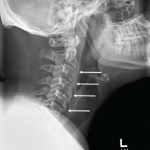So what might be the metabolic link connecting obesity, diabetes, and DISH? It has been observed that insulin-like growth factor-I stimulates alkaline phosphatase activity in osteoblasts and that growth hormone can induce the local production of this factor and its binding proteins in chondrocytes and osteoblasts. DISH patients have elevated insulin and growth hormone levels, which may explain the robust osteoblast cell growth and proliferation seen in this condition.
Other studies have suggested possible roles for matrix Gla protein, bone morphogenetic protein-2, and possibly leptin. Dickkopf-1 (DKK-1) is an inhibitor of osteoblastogenesis. Higher levels of DKK-1 are related to bone resorption, whereas lower levels are linked to new bone formation. A recent study observed that total circulating DKK-1 levels are lower in patients with DISH and may correlate with the severity of spinal involvement.
What About Pain?
So what about pain in patients with DISH? A major clinical tenet has been the lack of an association between DISH and pain. Based on this assumption, I dismissed the painful back symptoms described by my ungrateful patient. The literature on this subject is scant, but one of the best-designed studies to address this issue actually observed a reduction in self-reported incidences of back pain in elderly men with DISH compared with age-matched controls. There may be a corollary to this observation; that is, the presence of pain should suggest other possible causes of back pain such as occult vertebral fracture. On the other hand, the cervical spine region involvement by DISH can be more problematic for two reasons. First, some of the more sizable osteophytes may impinge on the adjacent esophageal structures resulting in dysphagia. Second, there may be ligamentous calcification adjacent to the spinal cord. Non-Asian patients with DISH generally have ossification of the anterior longitudinal ligament developing anywhere along the spine. Since this ligament sits on the far side of the vertebra, away from where the cervical or thoracic spinal cord resides, it cannot impinge or irritate the cord. This is not the case for the posterior longitudinal ligament.
In some DISH patients, primarily those of Asian descent, there is a curious condition known as ossification of the posterior longitudinal ligament (OPLL). It can be seen in about 2% of the Japanese population, though the majority of patients are asymptomatic. Since the posterior longitudinal ligament and the spinal cord are neighbors, any excessive calcification in this area can cause extreme neck pain with nuchal rigidity mimicking meningitis. Sometimes it can present as a cervical myelopathy with extremity numbness and weakness.

